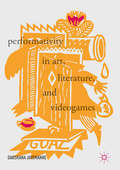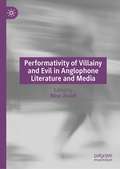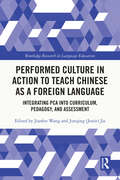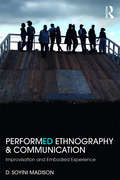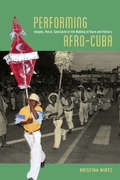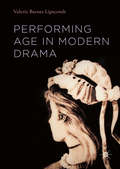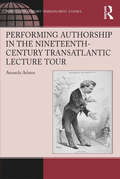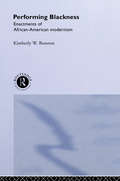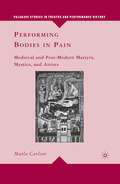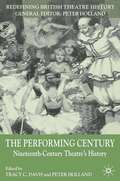- Table View
- List View
Performativity and Performance
by Eve Kosofsky Sedgwick Andrew ParkerFrom the age of Aristotle to the age of AIDS, writers, thinkers, performers and activists have wresteled with what "performance" is all about. At the same moment, "performativity"--a new concept in language theory--has become a ubiquitous term in literary studies. This volume grapples with the nature of these two key terms whose traces can be found everywhere: in the theatre, in the streets, in philosophy, in questions of race and gender, and in the sentences we speak.
Performativity in Art, Literature, and Videogames
by Darshana JayemanneThis book modifies the concept of performativity with media theory in order to build a rigorous method for analyzing videogame performances. Beginning with an interdisciplinary exploration of performative motifs in Western art and literary history, the book shows the importance of framing devices in orienting audiences’ experience of art. The frame, as a site of paradox, links the book’s discussion of theory with close readings of texts, which include artworks, books and videogames. The resulting method is interdisciplinary in scope and will be of use to researchers interested in the performative aspects of gaming, art, digital storytelling and nonlinear narrative.
Performativity in Art, Literature, and Videogames
by Darshana JayemanneThis book modifies the concept of performativity with media theory in order to build a rigorous method for analyzing videogame performances. Beginning with an interdisciplinary exploration of performative motifs in Western art and literary history, the book shows the importance of framing devices in orienting audiences’ experience of art. The frame, as a site of paradox, links the book’s discussion of theory with close readings of texts, which include artworks, books and videogames. The resulting method is interdisciplinary in scope and will be of use to researchers interested in the performative aspects of gaming, art, digital storytelling and nonlinear narrative.
Performativity in Elizabeth Gaskell’s Shorter Fiction: A Case Study in the Uses of Theory
by Melissa SchaubThis book simultaneously examines the specific theoretical issues raised by Elizabeth Gaskell’s use of characterization in her shorter fiction, and addresses the larger question of how literary critics ought to use theory. The text gives a history of Judith Butler’s theory of performativity and the uptake of that theory in literary criticism, and also provides detailed close reading of Gaskell’s fiction—both frequently examined texts like Cranford, Mary Barton, and Wives and Daughters, and some that are less often studied, such as “Lizzie Leigh” and Cousin Phillis. The book argues that as theory becomes naturalized into the vocabulary of literary scholars, it often becomes more optimistic and less specific. In discussing the naturalization of theory exemplified by the application of performativity to Gaskell, the book advances general principles on the use of theory. It can be read as scholarship or used as a textbook in literary methods courses.
Performativity of Villainy and Evil in Anglophone Literature and Media
by Nizar ZouidiPerformativity of Villainy and Evil in Anglophone Literature and Media studies the performative nature of evil characters, acts and emotions across intersecting genres, disciplines and historical eras. This collection brings together scholars and artists with different institutional standings, cultural backgrounds and (inter)disciplinary interests with the aim of energizing the ongoing discussion of the generic and thematic issues related to the representation of villainy and evil in literature and media. The volume covers medieval literature to contemporary literature and also examines important aspects of evil in literature such as social and political identity, the gothic and systemic evil practices. In addition to literature, the book considers examples of villainy in film, TV and media, revealing that performance, performative control and maneuverability are the common characteristics of villains across the different literary and filmic genres and eras studied in the volume.
Performed Culture in Action to Teach Chinese as a Foreign Language: Integrating PCA into Curriculum, Pedagogy, and Assessment (Routledge Research in Language Education)
by Jianfen Wang Junqing Jessie JiaThis volume explores best practices in implementing the Performed Culture Approach (PCA) in teaching Chinese as a foreign language (CFL).Offering a range of chapters that demonstrate how PCA has been successfully applied to curriculum, instructional design, and assessment in CFL programs and classrooms at various levels, this text shows how PCA’s culture-focused paradigm differs fundamentally from the general communicative language teaching (CLT) framework and highlights how it can inspire innovative methods to better support learners’ ability to navigate target culture and overcome communication barriers. Additional applications of PCA in the development of learner identity, intercultural competence, autonomy, and motivation are also considered.Bridging theoretical innovations and the practice of curriculum design and implementation, this work will be of value to researchers, teacher trainers, and graduate students interested in Chinese teaching and learning, especially those with an interest in incorporating performance into foreign language curriculums with the goal of integrating language and culture.
Performed Culture in Action to Teach Chinese as a Foreign Language: Integrating PCA into Curriculum, Pedagogy, and Assessment (Routledge Research in Language Education)
by Jianfen Wang Junqing Jessie JiaThis volume explores best practices in implementing the Performed Culture Approach (PCA) in teaching Chinese as a foreign language (CFL).Offering a range of chapters that demonstrate how PCA has been successfully applied to curriculum, instructional design, and assessment in CFL programs and classrooms at various levels, this text shows how PCA’s culture-focused paradigm differs fundamentally from the general communicative language teaching (CLT) framework and highlights how it can inspire innovative methods to better support learners’ ability to navigate target culture and overcome communication barriers. Additional applications of PCA in the development of learner identity, intercultural competence, autonomy, and motivation are also considered.Bridging theoretical innovations and the practice of curriculum design and implementation, this work will be of value to researchers, teacher trainers, and graduate students interested in Chinese teaching and learning, especially those with an interest in incorporating performance into foreign language curriculums with the goal of integrating language and culture.
Performed Ethnography and Communication: Improvisation and Embodied Experience
by D Soyini MadisonPerformed Ethnography and Communication explores the relationships between these three key terms, addressing the impact of ethnography and communication on the cutting edge of performance studies. Ranging from digital performance, improvisation and the body, to fieldwork and staged collaboration, this volume is divided into two main sections: "Embodied technique and practice," which addresses improvisation, devised theatre-making, and body work to consider what makes bodies move, sound, behave, mean, or appear differently, and the effects of these differences on performance; "Oral history and personal narrative performance," which is concerned with the ways personal stories and histories might be transformed into public events, looking at questions of perspective, ownership, and reception. Including specific historical and theoretical case studies, exercises and activities, and practical applications for improvisation, ethnography, and devised and digital performance, Performed Ethnography and Communication represents an invaluable resource for today’s student of performance studies, communication studies or cultural studies.
Performed Ethnography and Communication: Improvisation and Embodied Experience
by D Soyini MadisonPerformed Ethnography and Communication explores the relationships between these three key terms, addressing the impact of ethnography and communication on the cutting edge of performance studies. Ranging from digital performance, improvisation and the body, to fieldwork and staged collaboration, this volume is divided into two main sections: "Embodied technique and practice," which addresses improvisation, devised theatre-making, and body work to consider what makes bodies move, sound, behave, mean, or appear differently, and the effects of these differences on performance; "Oral history and personal narrative performance," which is concerned with the ways personal stories and histories might be transformed into public events, looking at questions of perspective, ownership, and reception. Including specific historical and theoretical case studies, exercises and activities, and practical applications for improvisation, ethnography, and devised and digital performance, Performed Ethnography and Communication represents an invaluable resource for today’s student of performance studies, communication studies or cultural studies.
The Performer in Mass Media: Connecting with Television and Online Audiences
by Beth OlsonThis book is a concise guide written by two individuals who have been there—under the lights and in front of the camera. Its no-nonsense approach offers readers practical advice about on-camera performance, including key aspects of voice, movement, communication and appearance. It gives them a foundation for working in the studio, in the field and in front of an audience; it is ideal for media performers of any type, including those who work as reporters, company spokespersons, or community advocates.Recommendations include how to properly position oneself for a shot, how to improve articulation, how to deal with stress and how to best perform online. "Try-It-Out" exercises help readers put what they have learned into practice and prepare to be on camera. Key terms are bolded in the chapters and are collected in a book-end Glossary for easy reference.
The Performer in Mass Media: Connecting with Television and Online Audiences
by Beth OlsonThis book is a concise guide written by two individuals who have been there—under the lights and in front of the camera. Its no-nonsense approach offers readers practical advice about on-camera performance, including key aspects of voice, movement, communication and appearance. It gives them a foundation for working in the studio, in the field and in front of an audience; it is ideal for media performers of any type, including those who work as reporters, company spokespersons, or community advocates.Recommendations include how to properly position oneself for a shot, how to improve articulation, how to deal with stress and how to best perform online. "Try-It-Out" exercises help readers put what they have learned into practice and prepare to be on camera. Key terms are bolded in the chapters and are collected in a book-end Glossary for easy reference.
Performing Afro-Cuba: Image, Voice, Spectacle in the Making of Race and History
by Kristina WirtzVisitors to Cuba will notice that Afro-Cuban figures and references are everywhere: in popular music and folklore shows, paintings and dolls of Santería saints in airport shops, and even restaurants with plantation themes. In Performing Afro-Cuba, Kristina Wirtz examines how the animation of Cuba’s colonial past and African heritage through such figures and performances not only reflects but also shapes the Cuban experience of Blackness. She also investigates how this process operates at different spatial and temporal scales—from the immediate present to the imagined past, from the barrio to the socialist state. Wirtz analyzes a variety of performances and the ways they construct Cuban racial and historical imaginations. She offers a sophisticated view of performance as enacting diverse revolutionary ideals, religious notions, and racial identity politics, and she outlines how these concepts play out in the ongoing institutionalization of folklore as an official, even state-sponsored, category. Employing Bakhtin’s concept of “chronotopes”—the semiotic construction of space-time—she examines the roles of voice, temporality, embodiment, imagery, and memory in the racializing process. The result is a deftly balanced study that marries racial studies, performance studies, anthropology, and semiotics to explore the nature of race as a cultural sign, one that is always in process, always shifting.
Performing Afro-Cuba: Image, Voice, Spectacle in the Making of Race and History
by Kristina WirtzVisitors to Cuba will notice that Afro-Cuban figures and references are everywhere: in popular music and folklore shows, paintings and dolls of Santería saints in airport shops, and even restaurants with plantation themes. In Performing Afro-Cuba, Kristina Wirtz examines how the animation of Cuba’s colonial past and African heritage through such figures and performances not only reflects but also shapes the Cuban experience of Blackness. She also investigates how this process operates at different spatial and temporal scales—from the immediate present to the imagined past, from the barrio to the socialist state. Wirtz analyzes a variety of performances and the ways they construct Cuban racial and historical imaginations. She offers a sophisticated view of performance as enacting diverse revolutionary ideals, religious notions, and racial identity politics, and she outlines how these concepts play out in the ongoing institutionalization of folklore as an official, even state-sponsored, category. Employing Bakhtin’s concept of “chronotopes”—the semiotic construction of space-time—she examines the roles of voice, temporality, embodiment, imagery, and memory in the racializing process. The result is a deftly balanced study that marries racial studies, performance studies, anthropology, and semiotics to explore the nature of race as a cultural sign, one that is always in process, always shifting.
Performing Afro-Cuba: Image, Voice, Spectacle in the Making of Race and History
by Kristina WirtzVisitors to Cuba will notice that Afro-Cuban figures and references are everywhere: in popular music and folklore shows, paintings and dolls of Santería saints in airport shops, and even restaurants with plantation themes. In Performing Afro-Cuba, Kristina Wirtz examines how the animation of Cuba’s colonial past and African heritage through such figures and performances not only reflects but also shapes the Cuban experience of Blackness. She also investigates how this process operates at different spatial and temporal scales—from the immediate present to the imagined past, from the barrio to the socialist state. Wirtz analyzes a variety of performances and the ways they construct Cuban racial and historical imaginations. She offers a sophisticated view of performance as enacting diverse revolutionary ideals, religious notions, and racial identity politics, and she outlines how these concepts play out in the ongoing institutionalization of folklore as an official, even state-sponsored, category. Employing Bakhtin’s concept of “chronotopes”—the semiotic construction of space-time—she examines the roles of voice, temporality, embodiment, imagery, and memory in the racializing process. The result is a deftly balanced study that marries racial studies, performance studies, anthropology, and semiotics to explore the nature of race as a cultural sign, one that is always in process, always shifting.
Performing Afro-Cuba: Image, Voice, Spectacle in the Making of Race and History
by Kristina WirtzVisitors to Cuba will notice that Afro-Cuban figures and references are everywhere: in popular music and folklore shows, paintings and dolls of Santería saints in airport shops, and even restaurants with plantation themes. In Performing Afro-Cuba, Kristina Wirtz examines how the animation of Cuba’s colonial past and African heritage through such figures and performances not only reflects but also shapes the Cuban experience of Blackness. She also investigates how this process operates at different spatial and temporal scales—from the immediate present to the imagined past, from the barrio to the socialist state. Wirtz analyzes a variety of performances and the ways they construct Cuban racial and historical imaginations. She offers a sophisticated view of performance as enacting diverse revolutionary ideals, religious notions, and racial identity politics, and she outlines how these concepts play out in the ongoing institutionalization of folklore as an official, even state-sponsored, category. Employing Bakhtin’s concept of “chronotopes”—the semiotic construction of space-time—she examines the roles of voice, temporality, embodiment, imagery, and memory in the racializing process. The result is a deftly balanced study that marries racial studies, performance studies, anthropology, and semiotics to explore the nature of race as a cultural sign, one that is always in process, always shifting.
Performing Afro-Cuba: Image, Voice, Spectacle in the Making of Race and History
by Kristina WirtzVisitors to Cuba will notice that Afro-Cuban figures and references are everywhere: in popular music and folklore shows, paintings and dolls of Santería saints in airport shops, and even restaurants with plantation themes. In Performing Afro-Cuba, Kristina Wirtz examines how the animation of Cuba’s colonial past and African heritage through such figures and performances not only reflects but also shapes the Cuban experience of Blackness. She also investigates how this process operates at different spatial and temporal scales—from the immediate present to the imagined past, from the barrio to the socialist state. Wirtz analyzes a variety of performances and the ways they construct Cuban racial and historical imaginations. She offers a sophisticated view of performance as enacting diverse revolutionary ideals, religious notions, and racial identity politics, and she outlines how these concepts play out in the ongoing institutionalization of folklore as an official, even state-sponsored, category. Employing Bakhtin’s concept of “chronotopes”—the semiotic construction of space-time—she examines the roles of voice, temporality, embodiment, imagery, and memory in the racializing process. The result is a deftly balanced study that marries racial studies, performance studies, anthropology, and semiotics to explore the nature of race as a cultural sign, one that is always in process, always shifting.
Performing Afro-Cuba: Image, Voice, Spectacle in the Making of Race and History
by Kristina WirtzVisitors to Cuba will notice that Afro-Cuban figures and references are everywhere: in popular music and folklore shows, paintings and dolls of Santería saints in airport shops, and even restaurants with plantation themes. In Performing Afro-Cuba, Kristina Wirtz examines how the animation of Cuba’s colonial past and African heritage through such figures and performances not only reflects but also shapes the Cuban experience of Blackness. She also investigates how this process operates at different spatial and temporal scales—from the immediate present to the imagined past, from the barrio to the socialist state. Wirtz analyzes a variety of performances and the ways they construct Cuban racial and historical imaginations. She offers a sophisticated view of performance as enacting diverse revolutionary ideals, religious notions, and racial identity politics, and she outlines how these concepts play out in the ongoing institutionalization of folklore as an official, even state-sponsored, category. Employing Bakhtin’s concept of “chronotopes”—the semiotic construction of space-time—she examines the roles of voice, temporality, embodiment, imagery, and memory in the racializing process. The result is a deftly balanced study that marries racial studies, performance studies, anthropology, and semiotics to explore the nature of race as a cultural sign, one that is always in process, always shifting.
Performing Age in Modern Drama
by Valerie Barnes LipscombThis book is the first to examine age across the modern and contemporary dramatic canon, from Arthur Miller and Tennessee Williams to Paula Vogel and Doug Wright. All ages across the life course are interpreted as performance and performative both on page and on stage, including professional productions and senior-theatre groups.The common admonition "act your age" provides the springboard for this study, which rests on the premise that age is performative in nature, and that issues of age and performance crystallize in the theatre.Dramatic conventions include characters who change ages from one moment to the next, overtly demonstrating on stage the reiterated actions that create a performative illusion of stable age. Moreover, directors regularly cast actors in these plays against their chronological ages. Lipscomb contends that while the plays reflect varying attitudes toward performing age, as a whole they reveal a longing for an ageless self, a desire to present a consistent, unified identity. The works mirror prevailing social perceptions of the aging process as well as the tension between chronological age, physiological age, and cultural constructions of age.
Performing Authorship in the Nineteenth-Century Transatlantic Lecture Tour (Ashgate Series in Nineteenth-Century Transatlantic Studies)
by Amanda AdamsExpanding our understanding of what it meant to be a nineteenth-century author, Amanda Adams takes up the concept of performative, embodied authorship in relationship to the transatlantic lecture tour. Adams argues that these tours were a central aspect of nineteenth-century authorship, at a time when authors were becoming celebrities and celebrities were international. Spanning the years from 1834 to 1904, Adams’s book examines the British lecture tours of American authors such as Frederick Douglass, Harriet Beecher Stowe, and Mark Twain, and the American lecture tours of British writers that include Harriet Martineau, Charles Dickens, Oscar Wilde, and Matthew Arnold. Adams concludes her study with a discussion of Henry James, whose American lecture tour took place after a decades-long absence. In highlighting the wide range of authors who participated in this phenomenon, Adams makes a case for the lecture tour as a microcosm for nineteenth-century authorship in all its contradictions and complexity.
Performing Authorship in the Nineteenth-Century Transatlantic Lecture Tour (Ashgate Series in Nineteenth-Century Transatlantic Studies)
by Amanda AdamsExpanding our understanding of what it meant to be a nineteenth-century author, Amanda Adams takes up the concept of performative, embodied authorship in relationship to the transatlantic lecture tour. Adams argues that these tours were a central aspect of nineteenth-century authorship, at a time when authors were becoming celebrities and celebrities were international. Spanning the years from 1834 to 1904, Adams’s book examines the British lecture tours of American authors such as Frederick Douglass, Harriet Beecher Stowe, and Mark Twain, and the American lecture tours of British writers that include Harriet Martineau, Charles Dickens, Oscar Wilde, and Matthew Arnold. Adams concludes her study with a discussion of Henry James, whose American lecture tour took place after a decades-long absence. In highlighting the wide range of authors who participated in this phenomenon, Adams makes a case for the lecture tour as a microcosm for nineteenth-century authorship in all its contradictions and complexity.
Performing Autobiography: Narrating a Life as Activism
by Katrina M. PowellPerforming Auto/biography: Narrating a Life as Activism analyzes the rhetorical strategies employed in five authors’ auto/biographical texts, examining their representations of identities and the public implications of writing individual identity. Exploring the ways race, class, culture, ethnicity, gender, and sexuality might affect the form(s) in which writers choose to write (e.g., memoir, fictional autobiography, poetry), questions how autobiographers challenge notions of genre, truth, and representation. This builds on the argument that constructing identity is a Performing Autobiography performance, one that can simultaneously use and subvert traditional notions of rhetoric and genre. By examining the auto/biographical texts of Zora Neale Hurston, Audre Lorde, Dorothy Allison, Joyce Johnson, and Shirley Geok-lin Lim together, the book theorizes self-representation and genres as rhetorical performances, and therefore their texts can be seen as “performative auto/biography”—transgressive archives where readers are asked to consider their own identities and act accordingly. In doing so, this book contributes to growing theories in feminist rhetorics and auto/biography studies, arguing that these performative genres advocate for life narratives as political and social activism.
Performing Blackness: Enactments of African-American Modernism
by Kimberley W. BenstonPerforming Blackness offers a challenging interpretation of black cultural expression since the Black Arts Movement of the 1960s. Exploring drama, music, poetry, sermons, and criticism, Benston offers an exciting meditation on modern black performance's role in realising African-American aspirations for autonomy and authority. Artists covered include: * John Coltrane* Ntozake Shange * Ed Bullins * Amiri Baraka * Adrienne Kennedy * Michael Harper. Performing Blackness is an exciting contribution to the ongoing debate about the vitality and importance of black culture.
Performing Blackness: Enactments of African-American Modernism
by Kimberley W. BenstonPerforming Blackness offers a challenging interpretation of black cultural expression since the Black Arts Movement of the 1960s. Exploring drama, music, poetry, sermons, and criticism, Benston offers an exciting meditation on modern black performance's role in realising African-American aspirations for autonomy and authority. Artists covered include: * John Coltrane* Ntozake Shange * Ed Bullins * Amiri Baraka * Adrienne Kennedy * Michael Harper. Performing Blackness is an exciting contribution to the ongoing debate about the vitality and importance of black culture.
Performing Bodies in Pain: Medieval and Post-Modern Martyrs, Mystics, and Artists (Palgrave Studies in Theatre and Performance History)
by M. CarlsonThis text analyzes the cultural work of spectacular suffering in contemporary discourse and late-medieval France, reading recent dramatizations of torture and performances of self-mutilating conceptual art against late-medieval saint plays.
The Performing Century: Nineteenth-Century Theatre's History (Redefining British Theatre History)
by T. Davis P. HollandThis book looks at modes of performance and forms of theatre in Nineteenth-century Britain and Ireland. On subjects as varied as the vogue for fairy plays to the representation of economics to the work of a parliamentary committee in regulating theatres, the authors redefine what theatre and performance in the Nineteenth century might be.

